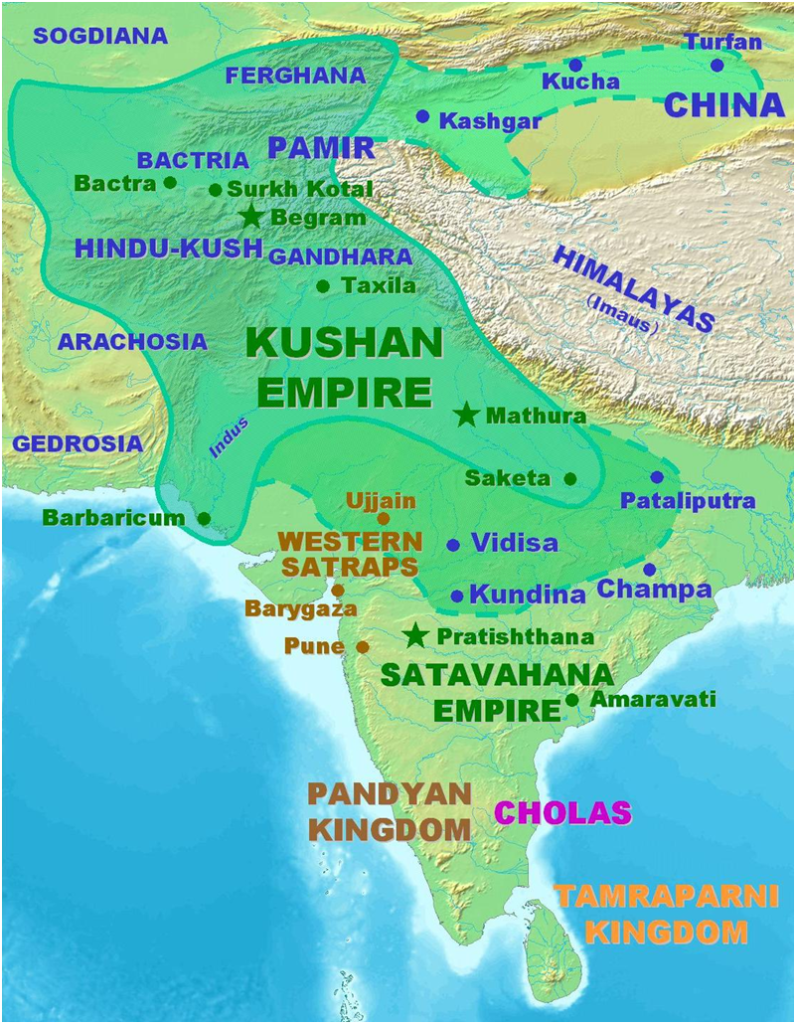• King Kanishka I was a brave warrior and is regarded as the greatest Kushan King.
• He was a great conqueror and a patron of Buddhism.
• He had both the military ability of Chandragupta Maurya and the religious zeal of Samrat Ashoka.
• He is also remembered for convening the Fourth Buddhist Council which was presided by Asvaghosa.
• After the death of Vima Kadphises a struggle for supremacy started among his governors and Kanishka won the battle to establish his authority .
• Then, he also conquered Punjab, Sind and the North-Western India and became the emperor of a vast tract of land.
THE SAKA ERA
• The era started by King Kanishka came to be known as the Sakabda or Saka era.
• It was started in 78 A.D. and marks the year of his accession.
EXTENT OF KANISHKA EMPIRE
• The Epigraphic records show that U.P., Punjab, North Western Frontier Province and a part of Sind were ruled by him.
• In the east Mathura was also under his control.

• We have also found his inscriptions at Banaras and that of his immediate successors at Sanchi in Malwa. Possibly, Malwa was also ruled by King Kanishka.
• The famous Muslim writer Alberuni told us that King Kanishka ruled over Afghanistan and the adjoining parts of Central Asia.
• The Chinese traveler Hiuen-Tsang told us that Kanishka’s territory included Gandhara, Peshawar and the east of Tsun-Ling Mountain.
• As per the records of Chinese and Tibetan historians it appears that King Kanishka conquered the Eastern India by annexing Ayodhya, Pataliputra and thus pacified the country which shows that he had conquered Bihar also.
• Kalhan’s Rajatarangini and some Buddhist Traditions also told us that King Kanishka added Kashmir also in his territory.
• Kanishka’s coins have been discovered at Tamluk in Midnapur district, Bogra, Murshidabad and Maldah areas of Bengal. This evidence strongly shows that the whole of Bengal was included in Kanishka’s kingdom.
Must read: “Dhamma ” of Ashoka
KANISHKA’S COINS

• Kanishka’s coins portray images of Indian, Greek, Iranian and even Sumero-Elamite divinities, demonstrating the religious syncretism in his beliefs.
• Kanishka’s coins from the beginning of his reign bear legends in Greek language and script and depict Greek divinities.
• Later coins bear legends in Bactrian, the Iranian language that the Kushans evidently spoke, and Greek divinities were replaced by corresponding Iranian ones.
KANISHKA AND BUDDHISM
• The Buddhists authors have claimed King Kanishka as faithful to Buddhism. They claimed that Kanishka in his later days being regretful of his past deeds, had embraced Buddhism for peace and consolation.
• Asvaghosha virtually converted Kanishka into a Buddhist.
• When Kanishka came along with his forces to Patliputra, he is said to have met the great Buddhist saint and scholar, Asvaghosha.
• Kanishka was so much charmed by his personality, personal character, knowledge and practicability of his teachings that he accepted his religion and declared himself to be an Upasak.
• Kanishka did a lot for the spread of Buddhism in his days. With the help of the Greek architect Agesiles, he erected a great relic tower at Peshawar which was admired by the whole Buddhist world.
• Kanishka had accepted the Mahayana creed of Buddhism as his state religion.
• He was the messanger of the Mahayana creed in Central Asia.
• It was this Mahayana creed so earnestly postulated by Kanishka, which eventually gave rise to a distinctive style of art, the Gandhara art.
• It should also be remembered that though an devoted Buddhist by faith Kanishka remained tolerant to all other faiths prevalent in his days and his coins serve as the best evidence of this fact.
• His court was graced by well-known scholars like Asvaghosha, Nagarjuna, Parsva, Vasumitra and Charaka.
KANISHKA Vs ASHOKA
• Kanishka has been likened to Ashoka as a conqueror, preacher.
• But although he was definitely a lesser personality than Great Ashoka, he was the nearest emulator of Ashoka in his spirit of toleration of other religions, patronage of Buddhism and missionary zeal.
• He however, was not an apostle of non-violence as Ashoka had been yet he had initiated a cultural renaissance which reached its zenith under the Guptas.
KANISHKA – A GREAT PATRON OF ART
• He was a great patron of art and architecture.
• The city of Purushapura, his capital, Taxila, Mathura were beautified by monasteries, stupas etc.
• The tall Chaitya at his capital with its sculpture forced the admiration of visitors even after long time.
KANISHKA – A GREAT KING
• .Kanishka’s reign constituted a brilliant epoch in the history of ancient India and the darkness that descended on the Indian History after the fall of the Mauryas lifted during his reign.
• Kanishka rightly deserves a place among the best rulers of the ancient history of India.
External link: https://en.wikipedia.org/wiki/Kanishka
